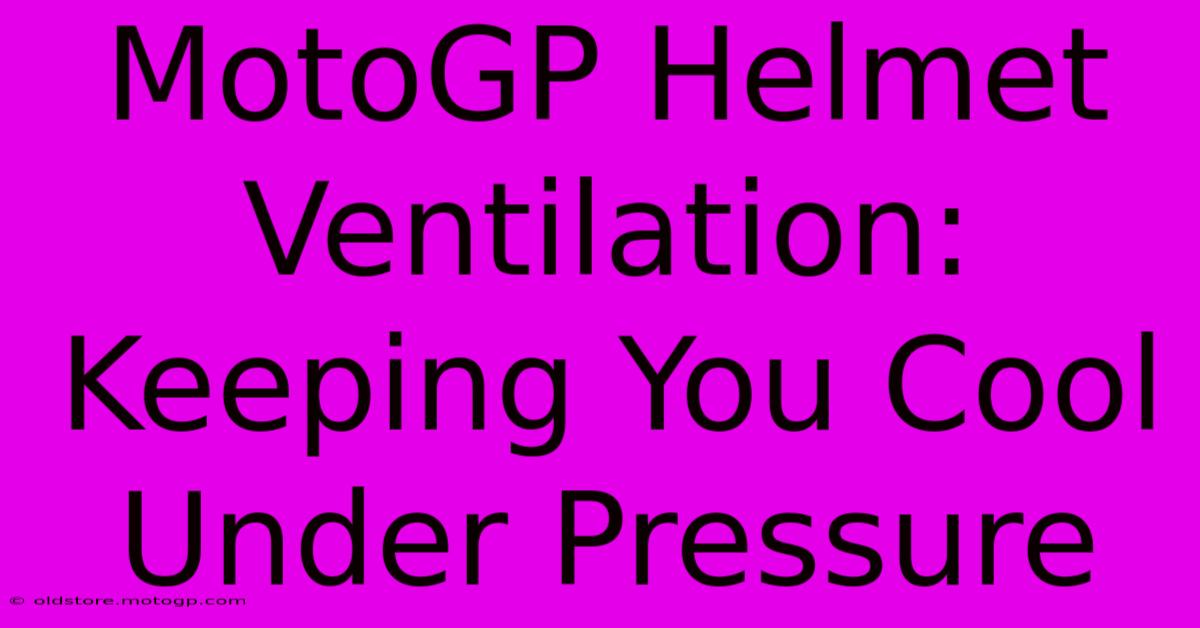MotoGP Helmet Ventilation: Keeping You Cool Under Pressure

Table of Contents
MotoGP Helmet Ventilation: Keeping You Cool Under Pressure
MotoGP racing pushes riders and their equipment to the absolute limit. While speed and skill are paramount, maintaining rider comfort and safety is equally crucial. One often-overlooked aspect is helmet ventilation. In the intense heat and physical exertion of a race, proper ventilation can be the difference between a strong performance and a complete meltdown. This article delves into the critical role of ventilation in MotoGP helmets, exploring the technology and design features that keep riders cool under pressure.
The Importance of Helmet Ventilation in MotoGP
The extreme conditions faced by MotoGP riders demand exceptional helmet ventilation. High speeds generate significant wind resistance and heat buildup within the helmet. The intense physical exertion of racing further increases body temperature and sweat production. Without adequate ventilation, riders risk overheating, dehydration, and impaired cognitive function – all of which can significantly impact performance and safety. Poor ventilation can also lead to fogging of the visor, drastically reducing visibility and increasing the risk of accidents.
The Impact of Heat on Rider Performance
Heat stress isn't just uncomfortable; it's debilitating. Elevated body temperature can lead to:
- Reduced concentration and reaction time: Crucial for making split-second decisions at high speeds.
- Muscle fatigue and cramping: Affecting rider control and endurance.
- Dehydration: Leading to dizziness, headaches, and impaired performance.
- Increased risk of errors: Putting both the rider and other racers at risk.
MotoGP Helmet Ventilation Technology: A Deep Dive
Modern MotoGP helmets are marvels of engineering, incorporating sophisticated ventilation systems to combat heat and humidity. These systems typically involve:
1. Multiple Air Intakes:
Strategically placed intakes on the chin bar, forehead, and crown direct airflow into the helmet. These intakes are often adjustable, allowing riders to fine-tune ventilation based on conditions.
2. Internal Air Channels:
A network of channels within the helmet shell guides the incoming air across the rider's head and face. This ensures even airflow distribution and maximizes cooling.
3. Exhaust Vents:
Rear and upper vents expel hot, humid air, creating a continuous flow-through ventilation system. These vents are often designed to minimize wind resistance while maximizing airflow efficiency.
4. Aerodynamic Design:
The helmet's overall shape plays a critical role in ventilation. Aerodynamic optimization ensures that airflow is channeled effectively while minimizing turbulence and drag.
5. Advanced Materials:
Lightweight, breathable materials like carbon fiber and advanced composites are used to construct the helmet shell. These materials offer superior strength and reduced weight while allowing for better airflow.
The Future of MotoGP Helmet Ventilation
Continuous innovation is driving advancements in helmet ventilation technology. We can expect to see further refinements in:
- Smart ventilation systems: Utilizing sensors to automatically adjust airflow based on rider temperature and ambient conditions.
- Improved aerodynamics: Reducing drag and optimizing airflow for even better cooling efficiency.
- More sustainable materials: Focusing on eco-friendly and high-performance materials.
Conclusion: Keeping Cool for Peak Performance
Effective helmet ventilation is a non-negotiable aspect of MotoGP safety and performance. The sophisticated technology incorporated into modern helmets is a testament to the importance of rider comfort and well-being. As the sport continues to evolve, expect even more advanced ventilation solutions to emerge, ensuring that MotoGP riders stay cool, focused, and at the peak of their performance.

Thank you for visiting our website wich cover about MotoGP Helmet Ventilation: Keeping You Cool Under Pressure. We hope the information provided has been useful to you. Feel free to contact us if you have any questions or need further assistance. See you next time and dont miss to bookmark.
Featured Posts
-
The Ultimate F1 Fan Experience Shuttle Service
Feb 18, 2025
-
The Thrill Of Competition Any Racing On Tv Today
Feb 18, 2025
-
Moto Gp Helmets A Buyers Guide
Feb 18, 2025
-
The Greatest Moto Gp Rider Changing The Game
Feb 18, 2025
-
Moto Gp Engine Power Unleashing The Beast Within
Feb 18, 2025
